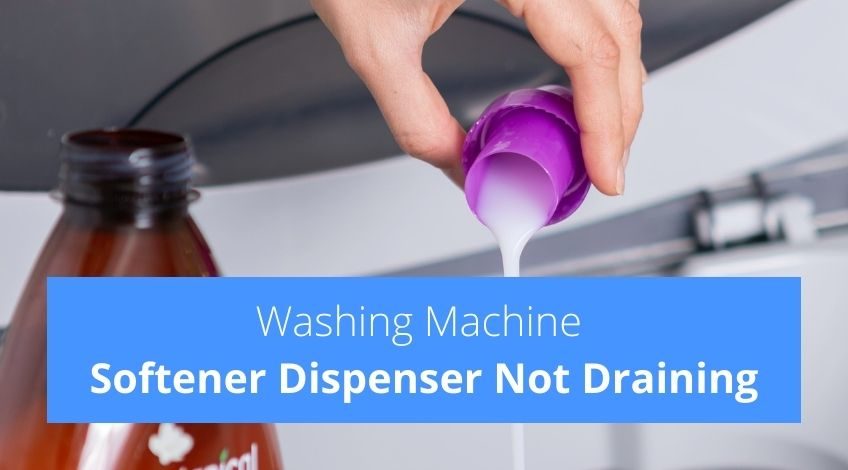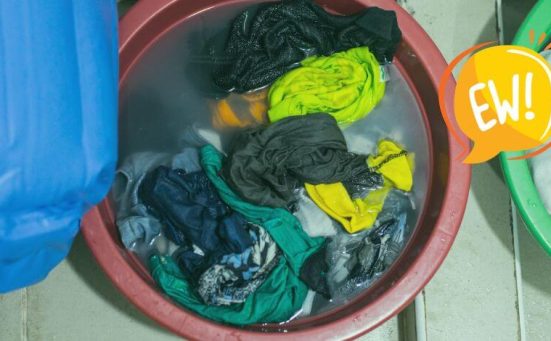
Washing Machine Softener Dispenser Not Draining? (try this)
If the fabric softener dispenser isn’t draining it can be a nuisance. Not only are you left with a gunky, wet mess in the detergent drawer, but your clothes will become stiff and scratchy. Don’t despair, there’s no need to replace the washing machine just yet. Keep reading for a number of possible solutions to this annoying problem.
Please note: Never tackle any electrical problems unless you are confident in maintaining your own personal safety and you fully understand what you are doing.
How Old Is Your Washing Machine?
The first thing to consider is the age of the machine, because, and here’s a first, this problem is far more likely to occur with a new machine. Yes, you read it right, a new washing machine.
That doesn’t mean the machine is faulty though, just that it’s not been levelled when it was installed. If you have recently had the machine installed, have a look at the feet and adjust them accordingly. Your problem could be as simple as that, and just as easy to fix.
Don’t Overload Your Machine
If you cram too many clothes into your washing machine, the fabric softener can get trapped between the clothes and therefore any residue will not have space to drain from the dispenser during the rinse cycle. Consult your manual for details on the correct maximum weight of clothes your drum can take.
Dispenser Clogged
Over time, the fabric softener residue can build up inside the dispenser and slow the rate of flow or block it completely. To remedy this, remove the dispenser from your machine, they usually just slide out. But if you notice any resistance it could have a release catch either at the back or on the side of the compartment. Once removed, soak the dispenser in a bucket of warm water for around 20 minutes and then lightly brush with a toothbrush.
Rinse off and before reinserting the dispenser, fill the compartment with water. If you’ve successfully removed all of the gunk, the water should drain out freely. If not, there are a number of ways to tackle the problem;
- Soak the dispenser in soda crystals for 20 minutes and then rinse thoroughly
- With the fabric softener dispenser still in the washing machine run a cycle with a dessert spoonful of soda crystals added (this is worth doing once a month to prevent any future build ups)
- Place the dispenser in the dishwasher and run a cleaning cycle
- With the dispenser removed from the washing machine, look above where the softener would sit, there should be a small line of holes. These holes can get blocked. To free any blockages gently push a cocktail stick into each hole, you should release a plug of gunky residue.
Cleaning Unremovable Detergent Dispensers

If your machine doesn’t have a removable dispenser, fill the dispenser with hot water, add a little liquid detergent and leave for 30 minutes. Rinse the dispenser with clean, hot water. If there is still residue, try wiping it with a soft cloth and rinse it again.
Once all signs of softener have been removed, run the rinse cycle selecting warm rinse if available on your machine. If warm rinse is not an option, pour hot water into the dispenser between rinses.
Low Water Pressure
If your water pressure is too low, the softener will not fully empty from the dispenser. To check that there are no blockages to the water inlet of your machine, consult your manual to locate the inlets and check for any blockages.
Wash Cycle Has Stopped
This can happen for a number of reasons, a simple power cut that only lasted for a few seconds is enough to stop the machine from completing its cycle. The problem with this is, you usually aren’t aware it’s happening because once the machine is running you go off and do other things, let’s face it, nobody is going to watch their washing machine for an hour plus.
Using Too Much Fabric Softener
Once you’ve solved the problem, be sure not to overfill the softener dispenser. As any residue will remain in the dispenser, dry out and cause the problem all over again. Also be aware that using powdered detergents in the liquid dispenser can cause blockages in other parts of the dispenser. Always remove the liquid dispenser cap if using Powdered detergent.
Other Ways To Prevent Softener Build-Up
We mentioned earlier about using soda crystals to clear any blockage and also as a preventative measure against further problems. But there are other methods that can be employed.
Run A White Vinegar Cleaning Cycle
White vinegar works equally as well. Pour two cups of white vinegar into the detergent drawer and run the machine empty (with no clothes) on a hot cycle.
If you are aware of a faint vinegar aroma after the cycle has finished, run the rinse program again. White vinegar works great for clearing calcium build-up in hard water areas which can cause softener and detergent residue issues.
Use A Thinner Fabric Softener
If the fabric softener you regularly use in your machine is very thick, it could cause a blockage over time. Either change to a thinner softener or dilute your regular softener with water in a 50/50 solution.
By using these preventative measures you will hopefully never encounter any problems in the future.
Frequently Asked Questions
During the cycle, the machine sends water to flush the softener into the drum and onto the clothes. Once the water flow is stopped, the compartment is temporarily filled with water. This should drain pretty fast, if it doesn’t then it’s possible there’s a blockage. Remove the dispenser and check for blockages.
Your washing machine might have insufficient water pressure to drain the fabric softener. This could be caused by blocked water filters, an outside (waterboard) fault or a build-up of softener residue clogging the dispenser.
You should never put fabric softener directly into the drum as this could damage your clothes. The softener needs to be diluted before reaching the clothes which is why it is placed in the dispenser which flushes it through with water at the correct point in the cycle.
Also, follow us on Pinterest ...



